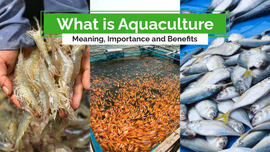Shrimp Cultivation in India: How to Make it a Profitable Business

The Shrimp cultivation in India has seen a significant rise over the years. It is a form of aquaculture primarily performed in brackish and marine waters. The increase in shrimp cultivation is because of the rising domestic and global demand. The shrimp business has significant export potential, thus attracting several people into shrimp cultivation businesses.
Table of Contents
Introduction
With a significantly huge coastline, India has extensive access to diverse marine resources. This allows the fisheries industry in the country to flourish. This growth is visible from the fact that the country’s fisheries industry has grown at around 8 per cent annually from 2014-15 to 2021-22. Diverse fishing practices are involved in this growth, and shrimp cultivation is one aspect. This blog discusses the practice of shrimp cultivation in India and how you can make it a profitable business if you are thinking of getting into this business.
Shrimp Cultivation in India
Shrimp Farming is a form of aquaculture primarily performed in brackish and marine waters. It is slightly different from fish farming as the focus is only on shrimps or prawns here. Shrimps are often interchangeably called Prawns as both have similar looks. In India, shrimp cultivation has been on the rise due to the increasing domestic and global demand. The shrimp business has significant export potential; thus, owners can have profitable shrimp cultivation businesses.
Shrimp Types
There are a variety of types of shrimp that can be cultivated and consumed. Here are some of the commonly grown types:
White Shrimp: This is one of the most popular shrimp (prawns) varieties, cultivated throughout the year but not in monsoon season. These are mostly found on the coasts of Karnataka and Kerala. These grow faster than other shrimp varieties and depend largely on water salinity and temperature.
Brown Shrimp: These have flatter and smaller bodies, but they are similar to prawns. The peak season for this type is from November to May, and they are found on the coasts of Odisha and Andhra Pradesh. With a mineral flavour, they are widely used for culinary purposes but are unsafe when consumed raw.
Vannamei Shrimp: Vannamei Shrimp, which is also commonly known as white-legged shrimp, is a freshwater prawn that was largely introduced in India in 2009 with certain guidelines regarding import, seed production and culture management in a bio-secured environment. These are often considered nutritious and healthy foods due to their bone-strengthening qualities.
Tiger Prawn: These prawns are cultivated from November to May and are found in India’s southwest and east coast. These are abundantly found on the coasts of Odisha and West Bengal. Due to their high protein content, vitamin E and zinc are often consumed and in high demand.
Flower Prawn: These are reared from October to February and are found in India’s east and west coasts. The states with an abundance of these prawns are Tamil Nadu, Gujrat, Goa, Maharashtra and Karnataka.
Pink Shrimp: Kerala and Karnataka coasts have an abundance of this type of prawn, which are reared from July to October.
Shrimp Farming Types
Shrimp culture involves a variety of farming approaches. These are
Organic Shrimp Farming: It involves rearing limited shrimps in a pond with a natural preservative approach. The lack of any chemical or preservative usage makes them organically raised. It is more costly than conventional shrimp farming approaches.
Biofloc Shrimp Farming: This approach involves improving water quality and following traditional shrimp farming practices. In this system, a suitable balance between nitrogen and carbon is created. This balance is developed through heterotrophic microbial growth simulation.
Indoor Shrimp Farming: This farming can be started by setting up a shrimp tank with sufficient infrastructure to pump, filter and manage water. It requires frequent monitoring and lags behind other forms in terms of profitability.
Intensive Shrimp Farming: This farming approach involves high seed density, complex layout and design calculation. It generates high waste, and thus, efficient waste management is also required for healthy prawn farming. Using coagulant treatment like alum majorly clears the ponds’ turbidity in prawn culture.
How to Make it a Profitable Business
With a growing shrimp culture, there is a high chance for individuals to get into the shrimp farming business. A similar case is with fish farming, which is growing exponentially. If you want to enter this field, you can easily learn how to start a profitable fish farming business in India. However, for the prawn cultivation business, here are a few things to make it profitable.
Market Research and Business Planning
Starting a business requires sufficient knowledge of the industry and proper research and planning.
- Select the type of shrimp farming you are interested in and the market demand for that variety.
- Identify the training, equipment, and costs associated with these beforehand.
- Research the necessary licenses and permits required.
- Develop a business plan incorporating every step of the business for smooth operation.
- Identify the infrastructure requirements, such as location, shrimp stocks, feeding mechanism, harvesting, and transportation system.
Acquiring the Necessary License and Permit
Based on location and the shrimp farming scale, you may have to gather licenses and permits to operate the business legally. Local regulatory authorities must be consulted to understand and gain the necessary permission to operate the business.
Developing Infrastructure for Shrimp Cultivation
Identifying location: Site selection is crucial for a successful shrimp farming business. The site should have a proper water supply. As shrimp prefer algae and larvae, keeping them in containers with a controlled environment is necessary. Treatment of ponds with copper sulphate at a per cent of one for the total alkalinity can help control blue green algae in prawn culture.
Stocking: Clear the area before stocking and use an organic method to prevent any infestation. Shrimps perform best in a lower-density stocking environment.
Feeding: Feeding shrimp twice daily is emphasized if you want to use them for commercial purposes.
Water and waste management: Regular water and waste management ensures a healthy supply of shrimp. A pH value of 7.5 to 8.5 is crucial in shrimp ponds, and thus, using lime along the pond edges can help mitigate the challenges of rainwater’s acidic nature.
Harvesting and Sales of Shrimp
After two months, harvesting can be done once the stocking is done. It is necessary to check whether shrimps are according to the size of demand in the market. Harvesting can be done in two forms: drain harvesting and cult harvesting. You can opt for a suitable approach. Once harvesting is done, it is important to transport these harvested prawns to the market without any damage. Focus on quality and freshness to improve sales.
Final Words
Shrimp farming or Prawn farming in India has seen a significant rise. With a huge coastline and inland water environments, starting a prawn cultivation business is an opportunity to get into the industry. However, it is necessary to understand all the aspects before entering the business to run a successful business and gain the most profit.
Frequently Asked Questions On Shrimp Cultivation in India: How to Make it a Profitable Business
1. What is prawn culture?
The prawn’s larval form is allowed entry to diverse culture fields for rearing and marketing. This system is called a prawn culture.
2. How to control blue green algae in prawn culture?
Treatment of ponds with copper sulphate at a per cent of one for the total alkalinity can help control blue green algae in prawn culture.
3. How many salinities need for prawn culture?
A salinity level of 10-25 ppt is optimal for prawn culture.
4. How to deal turbidity in prawn culture?
Using coagulant treatment like alum majorly clears the ponds’ turbidity in prawn culture.
5. How to do Vannamei prawn culture?
Vannamei Shrimp Culture or Vannamei Prawn Culture involves broodstock procurement, efficient water management, mating, spawning, incubation, larvae rearing, monitoring, stocking, feeding and careful harvesting.
6. How to protect freshwater prawn culture pond from rain?
A pH value of 7.5 to 8.5 is crucial in shrimp ponds, and thus, using lime along the pond edges can help mitigate the challenges of rainwater’s acidic nature


Related Blogs












